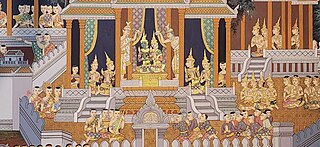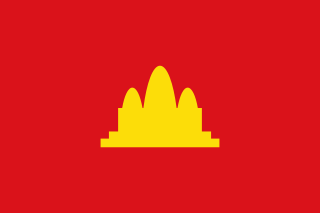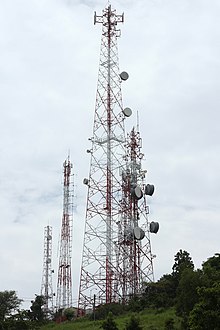Telecommunications in Belarus involves the availability and use of electronic devices and services, such as the telephone, television, radio or computer, for the purpose of communication.
Egypt has long been the cultural and informational centre of the Middle East and North Africa, and Cairo is the region's largest publishing and broadcasting centre.
Myanmar has begun the liberalization of its Telecommunication market in 2013.
Nigeria is Africa's largest ICT market, accounting for 82% of the continent's telecoms subscribers and 29% of internet usage. Globally, Nigeria ranks 11th in the absolute number of internet users and 7th in the absolute number of mobile phones.
Oman Telecommunication Company (Omantel) has a monopoly in the landline telephone and internet access markets. Its arm Omanmobile offers mobile services. The Omani government owns 70% of Omantel after 30% was listed for the public in 2005. In 2005 Qatar Telecommunication Company (Qtel) and partners were awarded the second license to offer mobile services in the country under the brand of Nawras, which is now rebranded as Ooredoo. Oman now has 5 mobile networks offering internet. The networks providing 4G coverage are Oman mobile, Ooredoo, [./Http://www.rennamobile.com/ Renna], RedBull Mobile and Friendi.

Phnom Penh is the capital and most populous city of Cambodia. It has been the national capital since the French protectorate of Cambodia and has grown to become the nation's primate city and its economic, industrial, and cultural centre. Before Phnom Penh became capital city, Oudong was the capital of the country.
The liberalization of Bangladesh's telecommunications sector began with small steps in 1989 with the issuance of a license to a private operator for the provision of inter alia cellular mobile services to compete with Bangladesh Telegraph and Telephone Board (BTTB), the previous monopoly provider of telecommunications services within Bangladesh. Significant changes in the number of fixed and mobile services deployed in Bangladesh occurred in the late 1990s and the number of services in operation has subsequently grown exponentially in the past five years.

Norodom Sihanouk was a Cambodian statesman, Sangkum and FUNCINPEC politician, film director, and composer who led Cambodia in various capacities throughout his long career, most often as both King and Prime Minister of Cambodia. In Cambodia, he is known as Samdech Euv. During his lifetime, Cambodia was under various regimes, from French colonial rule, a Japanese puppet state (1945), an independent kingdom (1953–1970), a military republic (1970–1975), the Khmer Rouge regime (1975–1979), a Vietnamese-backed communist regime (1979–1989), a transitional communist regime (1989–1993) to eventually another kingdom.

Samdech Hun Sen is a Cambodian politician and former military commander who served as the prime minister of Cambodia from 1985 to 2023. He is the longest-serving head of government in Cambodia's history. He is the president of the Cambodian People's Party (CPP), which has governed Cambodia since 1979, and a member of the National Assembly for Kandal. His full honorary title is Samdech Akka Moha Sena Padei Techo Hun Sen.
Articles related to Cambodia and Cambodian culture include:

Ieng Sary was the co-founder and senior member of the Khmer Rouge and one of the main architects of the Cambodian Genocide. He was a member of the Central Committee of the Communist Party of Kampuchea led by Pol Pot and served in the 1975–79 government of Democratic Kampuchea as foreign minister and deputy prime minister. He was known as "Brother Number Three" as he was third in command after Pol Pot and Nuon Chea. His wife, Ieng Thirith, served in the Khmer Rouge government as social affairs minister. Ieng Sary was arrested in 2007 and was charged with crimes against humanity but died of heart failure before the case against him could be brought to a verdict.

Media in Cambodia is vibrant and largely unregulated. This situation has led to the establishment of numerous radio, television and print media outlets. Many private sector companies have moved into the media sector, which represents a significant change from many years of state-run broadcasting and publishing.

Kampuchea, officially Democratic Kampuchea (DK) from 1976 onward, was the Cambodian state from 1975 to 1979, under the totalitarian dictatorship of Pol Pot and the Communist Party of Kampuchea (CPK), commonly known as the Khmer Rouge (KR). It was established following the Khmer Rouge's capture of the capital Phnom Penh, effectively ending the United States-backed Khmer Republic of Lon Nol.
The National Television of Cambodia is the national television station of Cambodia. It is owned and operated by the government of Cambodia in Phnom Penh together with the national radio station, National Radio of Cambodia. TVK is member of the Asia-Pacific Broadcasting Union (ABU).
Access to the Internet in Azerbaijan is growing, supported by a national strategy to develop the country into an information and communication technology (ICT) hub for the Caucasus region. The Azerbaijani government actively seeks to attract foreign aid to help boost the telecommunications and ICT sectors. While the government claims 85 percent of the population was online in 2013, service provider Baktelekom has provided free Wi-Fi zones in several points of Baku like the National Flag Square, the Boulevard, Old City, the park around the Heyder Aliyev Centre, parks of Sahil, Sabir, Samad Vurghun, Winter Park, as well as Port Baku Residence and Port Baku Mall.
Telecommunications in Angola include telephone, radio, television, and the Internet. The government controls all broadcast media with a nationwide reach.
Telecommunications in Ivory Coast include radio, television, fixed and mobile telephones, and the Internet.
The Ministry of Posts and Telecommunications is the government ministry that governs the postal system and the telecommunications systems of Cambodia. The ministry maintains offices in Phnom Penh.
The mass media in Gabon is primarily monitored by the Gabon government. Although the main newspapers are associated with the government, there are private broadcasters, and private weekly newspapers that are mostly controlled by opposition parties.
"Oh! Phnom Penh" is a Cambodian song written by Mum Bunnaray in 1979 as the Khmers Rouges left Phnom Penh and its population returned to a devastated city. It has been recognized as "Cambodia's heritage protected forever".









